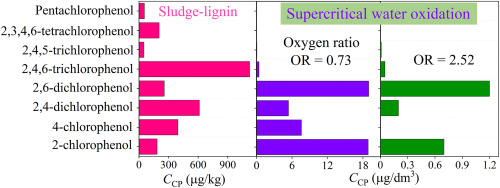В журнале Chemosphere (IF 7,086) опубликована статья с участием сотрудника Института к.х.н. С. В. Морозова (завлаб ЛЭИиХА)
Supercritical water oxidation of chlorinated waste from pulp and paper mill
Chemosphere, 2021, V. 238, November 2021, 131239
Abstract
The article presents the research results of the oxidation of watered toxic waste from the pulp and paper industry (sludge-lignin, the empirical formula of organic matter CH1.51N0.05S0.03Cl0.01O0.54) in supercritical water-oxygen (SCW/O2) fluid. The experiments were carried out using a flow tube reactor at a pressure of 25 MPa, temperature gradient along its vertical axis (from top to bottom: 390–600 °C), sludge-lignin flow rate of 9.5–14.5 g/min, oxygen ratio OR = 0.73–2.52, using NaOH (1.6 wt%) as a catalyst. Employing gas chromatography – mass spectrometry, polychlorophenols were identified in the composition of sludge-lignin, in which 2,4,6-trichlorophenol was the main component. The total yield of extracted phenols and chlorophenols per sludge-lignin organic matter was 20.82 and 2.88 μg/g, respectively. It is revealed that the conversion rate of sludge-lignin in SCW/O2 fluid is limited by heterogeneous oxidation of the carbonized residue, and is determined by the O2 content in the reaction mixture. At OR ≥ 1.16, only CO2, CO, N2, and N2O were detected in the volatile oxidation products. An increase in OR from 0.73 to 2.52 leads to a decrease in the total content of phenols (from 45540.1 to 129.3 μg/dm3) and chlorophenols (from 51.4 to 2.2 μg/dm3) in the water collected at the reactor outlet. It is shown that 2,6-dichlorophenol and 2-chlorophenol are the most resistant to oxidation. From the analysis of the initial sludge-lignin and mineral residues, it follows that the bulk of the chlorine contained in its organic matter is converted into NaCl in the course of oxidation.
Keywords: Waste disposal, Phenols, Chlorophenols, Supercritical water oxidation, Alkali catalyst
Альметрики:



